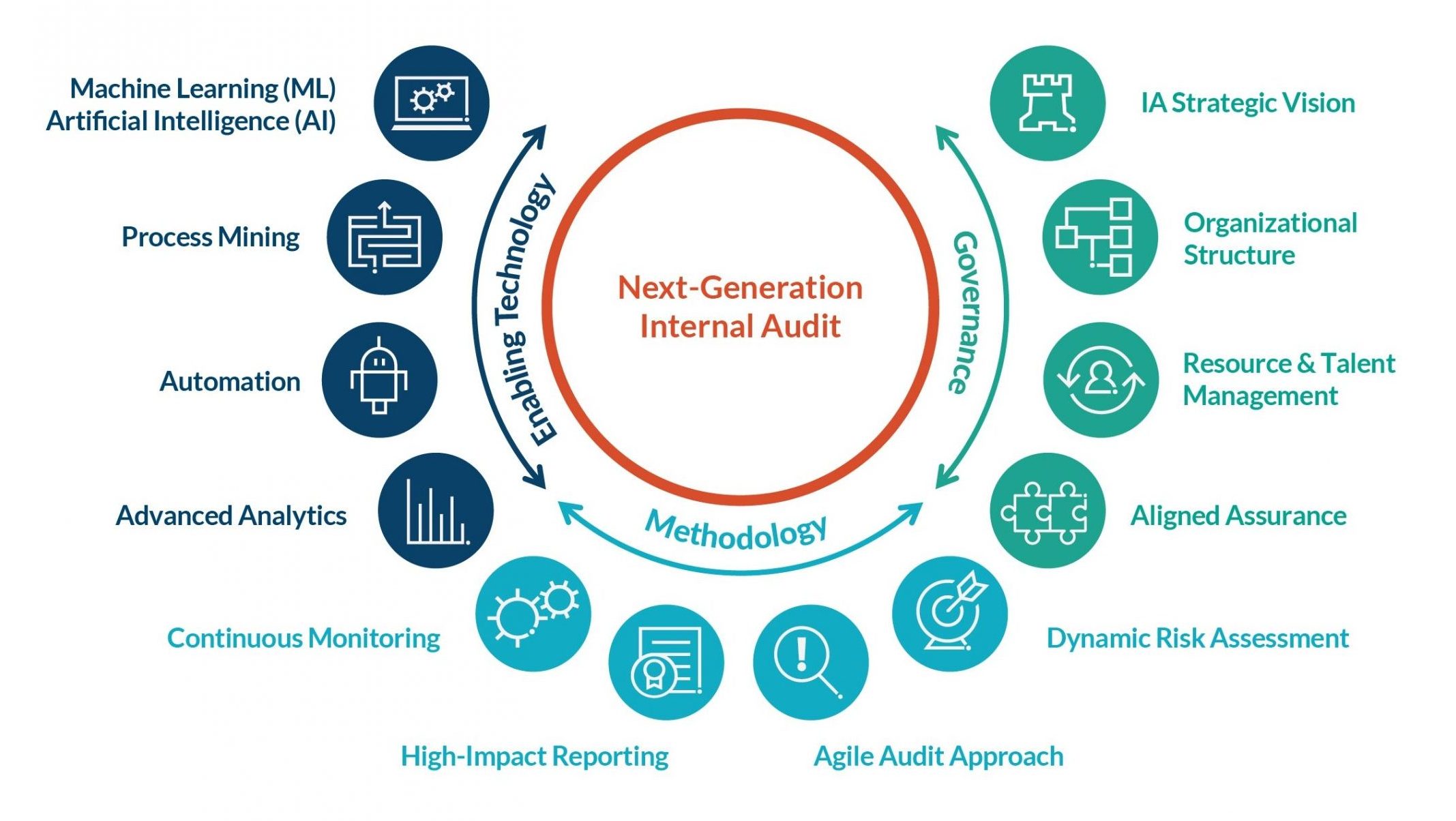Pandemic-related disruption drove most internal audit functions to rethink their audit plan and approach. On the positive side, the need to pivot frequently has allowed auditors to engage and support the business in new ways. And, according to results from Protiviti’s global 2021 Next-Generation Internal Audit Survey, nearly two-thirds (66%) of internal audit departments have increased their focus on innovation and transformation initiatives at least somewhat compared to a year ago.
Now, many internal audit leaders are looking to build on this positive momentum, especially as the COVID-19 crisis eases in many areas and the economic rebound takes hold. More specifically, they aim to accelerate their efforts to establish a next-generation function. And findings from our recent internal audit survey suggest this is the right mindset, as most internal audit organizations are still only in the early stages of their next-generation journey.
Many changes internal audit teams adopted during the pandemic were necessary measures designed to help the function better support the business during an unprecedented crisis. These changes ranged from implementing more and better technology tools to conducting new types of audits, like supply chain audits. But these were often reactive changes. Moving forward, proactive change is what will help internal audit departments move the needle faster on transformation.
Here are five strategies that internal audit leaders and their teams can use to jump-start, reinvigorate or advance their department’s next-gen evolution.
- Set a vision for the journey
Any transformation journey requires a goal or a vision for change that the organization needs to work toward. For internal audit, a starting point is determining why the function needs to transform, aside from the fact that it’s critical for the future.
For example, are business stakeholders demanding change from the function? Probably. They may be hungry for more relevant and outcome-based auditing. They don’t just want auditors to look at a process and confirm that it’s working as intended and compliant. They want to know how that process could be more efficient or innovative. And they definitely want more insight into the data auditors are analyzing, and to have that information presented in more compelling ways. (More on that later.)
Stakeholders’ expectations can shape the vision for internal audit’s transformation and give it purpose. And that vision, in turn, can create the necessary mindset for change within the function. One of the biggest obstacles in the next-gen journey is getting auditors to step out of their comfort zone to think differently and innovatively, and to be more open to trying new things, failing at some, and learning continuously.
Internal audit leaders are tasked with building that culture and mindset within their team (starting with themselves, of course). They can empower auditors to try new things and communicate what went right or wrong. And they can encourage them to innovate any aspect of the audit cycle and question whether the team needs to take the same worn paths in their approaches. Motivating the internal audit team to think constantly about innovation, even in small but significant ways, helps fuel the next-gen journey.
- Benchmark to chart a course for change
Another best practice to help internal audit functions crystallize the vision for their next-gen transformation is to benchmark their organization against others. This can inform the answers to questions such as:
- Where are we and where do we need to be?
- What are the steps on the road map to get us where we need to be?
- Should we conduct a maturity assessment?
- What metrics should we use to measure our progress?
A formal framework can help structure the benchmarking process. Protiviti offers one that can serve as a starting point. It includes the key governance, methodology and enabling technology components that we find are hallmarks of next-generation internal audit functions:
Nearly all the internal audit transformations we’ve seen have addressed most, if not all, of the competencies, qualities and components in the three broad categories shown above. We also applied this framework in our 2021 internal audit survey to help assess the maturity levels of respondents.
- Aim for quick wins that have impact
Even if stakeholders want to see internal audit evolve its practices, the amount of funding and other support needed to create the desired change isn’t always there to start. But we’ve seen many leading internal audit organizations overcome this obstacle by building up strengths they already have, encouraging their team members to explore new ideas and expand their abilities.
For instance, an internal audit function might look to an audit team member who is already skilled or interested in data analytics to advance their skills further. They can connect that person with more training to learn advanced analytics and then ask them to apply those new skills in their day-to-day work. Over time, that person can impart skills and knowledge to others on the team, and help the whole organization increase its use of advanced analytics in the auditing process.
Reporting is another area where internal audit can find quick wins for transformation — while also demonstrating the function’s value and relevance to the business. By using simplified, high-impact reporting that’s customized for target audiences, internal audit teams can better communicate what stakeholders need to know and allow them to get granular on the details that interest them most. Visually appealing and shorter reports, with less text and more useful graphics and in-depth data analysis, are ideal. (Not sure what stakeholders want to see? Ask them.)
- Market and get buy-in for agile auditing practices
Transitioning to a next-generation mindset involves adopting an agile mindset, along with a willingness to embrace change. The agile mindset is also foundational to agile auditing, an approach that demands internal audit and stakeholders focus on mitigating risks by responding to changing and emerging business needs and directions, while working to meet business and regulatory commitments.
When we meet with internal audit teams that want to take the next-generation journey, one of the first questions we typically hear is, “How do we get going with agile?” We suggest they begin by marketing the agile concept internally and getting buy-in from like-minded audit stakeholders — that is, groups already using agile working practices or that have a good working relationship with internal audit.
Then, internal audit and the select stakeholders can work together to choose small, pilot projects where they can begin applying an iterative approach to assessment, evaluation and feedback — and create a continuous loop for that feedback, so they can keep adding value to the audit all along the way.
So, start small, learn from the results and, perhaps most important, publish those results. In agile auditing, business owners are involved in the audit report process early. And the final reports, which deliver future-focused insights, include the viewpoints of both auditors and business owners. Promote the success of your collaboration and help the whole business understand the benefits of agile auditing.
- Designate a transformation champion
Finally, to ensure the next-gen journey stays on course toward the North Star vision, internal audit needs to identify who in the organization will be clearly accountable for the success of the function’s transformation. This role — such as a “transformation director” — is responsible for and focused on driving change in the internal audit organization.
According to our 2021 Next-Generation Internal Audit Survey results, nearly half (47%) of organizations that ranked as “digital leaders” have designated innovation/transformation “champions” within their internal audit department. Digital leaders in our survey are those that have adopted a mindset toward transformation, embraced an innovation-centric way of working, and learn and improve continuously. While even they have a way to go on their next-gen journey, they are well along the path.
Now is an ideal time for internal audit teams to build on all the change they’ve experienced and helped to spearhead over the past year. They can take advantage of business stakeholders’ newfound openness to working more collaboratively and even proactively with the internal audit function. Organizations are already disrupted. And as the business continues to change in response to new challenges, internal audit will need to keep changing right alongside it, too.
Start planning now for next-gen transformation success
Download our report, The Next-Generation Internal Audit Journey Needs to Begin Now, to view the full results from our recent survey, learn about the Protiviti digital maturity scale, and get tips on how to start creating a road map for your internal audit’s journey to become a next-gen function.
For more insights, listen to our podcast about our survey findings.







